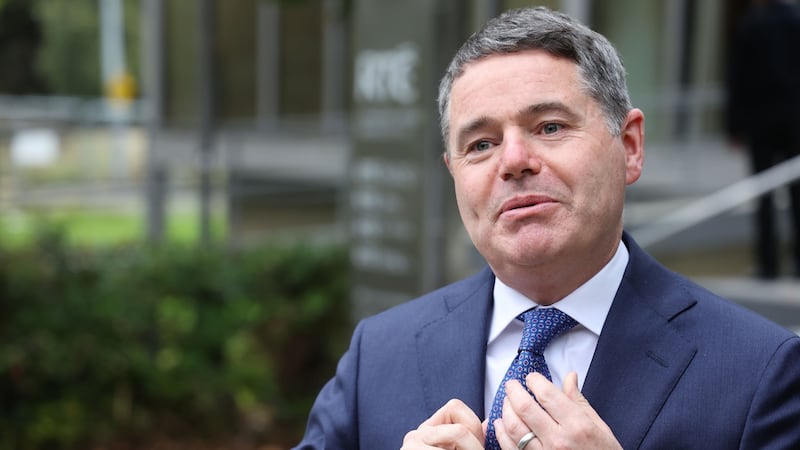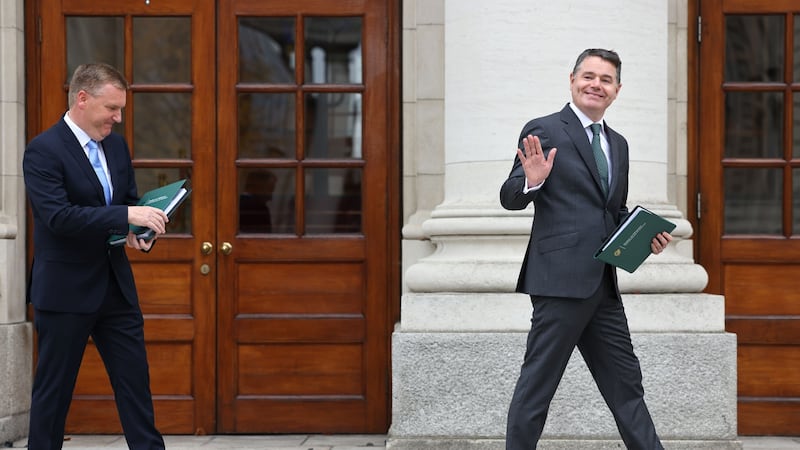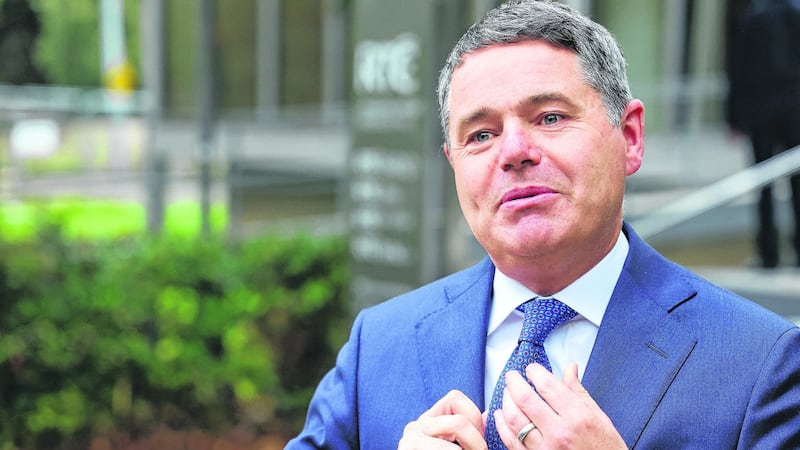Time for everyone to make their minds up, and Paschal Donohoe knew it.
It was last September, and months of negotiations on an unprecedented global agreement to make multinational companies pay more tax were reaching a decisive point. Ireland was at the epicentre of it.
Like many political deals, it boiled down several vastly complex issues to a single question: would the US move from a minimum corporation tax rate of “at least 15 per cent” to just “15 per cent”?
A central pillar of Ireland’s economic model hung in the balance and, probably, so did Donohoe’s political career. Privately he had estimated the chances of success to be about 50-50 some months previously. By September, the odds looked a little better. But it was still an audacious, and risky, position to take.
Ireland was asking the US, the EU and the OECD, and the representatives of the vast majority of the world’s countries who had indicated agreement with the “at least” text, to change their position to enable Donohoe to sign up. Some of his own officials doubted he could hold the line if the answer was no. Could Ireland, the most globalised of countries, really have stood against such an overwhelming international consensus?
But Donohoe knew that everyone wanted a deal, and he was offering one. During a number of conversations, he had made it clear to US treasury secretary Janet Yellen and other G7 finance ministers that if they could move and drop the "at least" qualification, he would deliver the commitment to change Ireland's corporation tax rate, clearing the way for international agreement. He would, he told them, get the approval of Cabinet and announce the measure in the Dáil on budget day. That was the deal on offer.
And while many people involved in the process doubted Ireland could remain outside the global agreement even if the “at least” formula remained, Donohoe had already stood against the consensus for months, and refused to sign up to the initial agreement in July, demonstrating at least his willingness to hold the process up.

[The tax rate] has been a pillar of economic policy for decades, as well known to the taxi drivers of Dublin as it is to the chief financial officers of global corporations
The Irish Minister for Finance had also spent months explaining to his colleagues that the tax rate in Ireland “is more than just a tax rate” in the words of one person closely involved; it has been a pillar of economic policy for decades, as well known to the taxi drivers of Dublin as it is to the chief financial officers of global corporations. Donohoe had hammered home the taxi driver point so effectively to Yellen that it became part of her own talking points when selling the deal.
Donohoe also reminded his interlocutors that Ireland had refused to give up its 12.5 per cent rate – despite overt pressure from France and Germany – when the economic crisis had pushed it into a humiliating bailout in 2010. If we weren't going to give it up when the State was bust, Donohoe told them, can you really expect us to give it up voluntarily now?
But that was precisely what he would do, he told them, if they would settle for 15 per cent and drop the “at least”. The assessment was Yellen and the OECD wanted a deal that everyone was signed up to more than they wanted “at least 15 per cent”. Not by nature one of life’s gamblers, Donohoe weighed the odds, and rolled the dice.
It had been a long road to this point. Successive Irish governments had been resisting efforts to interfere with the 12.5 per cent tax rate for at least 20 years. Partly because of the external threat to it – borne of the very obvious unhappiness of some EU member states with Ireland’s low rate, and success at attracting multinational investment – the 12.5 per cent rate grew to attain a totemic status, almost a national shibboleth.
It became not just a pillar of economic policy, but a symbol of Ireland’s independence, and economic success. It was a lighthouse to the world, helping to attract the hundreds of multinationals and the tens of billions of dollars in investment that had played a central role in transforming Ireland from an economic backwater to one of the richest countries in the world.
It was jealously guarded by politicians and voters alike. In European treaty referendums, opponents invariably espied a threat to the tax rate if the treaty was passed; before the rerun of the Lisbon Treaty, the then government secured a protocol promising there was no threat to Ireland's tax sovereignty. It wasn't just the taxi drivers; it was everyone.
The policy enjoyed a level of political support across the board that outsiders found difficult to fathom, but impossible to deny. As Donohoe wheedled and cajoled behind the scenes, Sinn Féin, the left-wing leaders of Ireland’s Opposition, warned him that failure to maintain the 12.5 per cent rate would be a political failure. For years, Ireland had simply dug in its heels against efforts to harmonise tax arrangements in the EU.
But that strategy was running out of road. Widespread multinational tax avoidance, at a time when national treasuries were bare after the economic crisis, had spawned a process to make the tech giants and others pay more tax, co-ordinated by the OECD, the Paris-based organisation of wealthier countries. The Irish Government had signed up to this process in part because it gave them an excuse to continue refusing EU initiatives. But now the OECD "Beps" process (base erosion and profit shifting) was heading towards a conclusion. Ministers knew it could cost Ireland billions of euros annually.
The big game-changer had been the election of Joe Biden as president of the United States. "That completely changed the context," says one person involved at a senior level right the way through. For years, the US and the EU had been pulling in different directions on tax; Ireland had comfortably surfed the middle way. Now, with Biden's commitment to securing an international agreement on corporation tax, the EU and the US were suddenly on the same side. That meant things would very likely change, and not to Ireland's advantage.
Early in the administration, Biden’s treasury secretary, Janet Yellen, made clear that this would be one of her priorities, not just because it was a key Democrat pledge to make the US tax system fairer, but because Biden needed the cash to pay for his gargantuan stimulus plan for the US economy. The Americans were pushing for a minimum rate of 21 per cent.

In Dublin, the realisation that the world had changed came quickly. The Minister for Finance briefed the Coalition party leaders and was careful to keep his Fianna Fáil colleague Michael McGrath – who held the public expenditure brief upstairs from Donohoe and, with him, formed the best functioning axis of the Government – in the loop. A group of senior officials, including the State's top civil servant Martin Fraser and a few other secretaries general, were also kept informed of developments.
In late April, Donohoe hosted an online international seminar from the Whitaker room in the Department of Finance, attended by a phalanx of senior officials, including his namesake Pascal Saint Amans from the OECD. He defended Ireland's rate, and stressed the need for certainty but said that Ireland would continue to engage with the OECD process, which had been turbo-charged by the US change of government.
I'm here as the president of the Eurogroup, not as Minister for Finance of Ireland, so this is a non-intervention
Just how much the process had gained momentum was brought home to Donohoe in London in June when the G7 finance ministers met and agreed that the emerging proposals should include a minimum rate of “at least 15 per cent”. As the discussions proceeded, Donohoe intervened. “I’m here as the president of the Eurogroup, not as Minister for Finance of Ireland, so this is a non-intervention,” he said. But he told them it was important they understood where Ireland was coming from, and laid out his position, explaining the importance of the 12.5 per cent to Ireland and defending small countries’ right to compete with larger countries through their tax rate. Irish officials were thrilled by his intervention – or “non-intervention”. But it was becoming clear how isolated Ireland was.
The following month, the OECD announced that 134 countries had signed up to an agreement to a minimum rate of corporation tax of “at least 15 per cent”. Donohoe refused to sign up, announcing that Ireland had stayed out. “What is on the table at the moment is an agreement that Ireland cannot be part of,” he said.
Privately, however, he told other leaders and finance ministers that Ireland wanted to join the agreement, but that he couldn't sign up to the existing terms. In a telephone call, Donohoe assured the OECD chief Matthias Cormann that he wanted to be "constructive". They agreed the line that Ireland was "out of the agreement but committed to the process". The apparent contradiction was a signal to everyone that Ireland would join in, but only if it got its changes.
Officials report that Ireland experienced significant blowback following the refusal to sign up to the July agreement. "Heavy, heavy, heavy leaning on us," one official recalls, directed not just at the Minister for Finance but at the Taoiseach's Office and the Department of Foreign Affairs. Donohoe thought it would be worse, and privately joked that he had got worse at the Fine Gael parliamentary party meetings. There was some criticism at home, and Green Party leader Eamon Ryan was deeply uncomfortable with the position. But he agreed to give Donohoe time to work on it.

For two hours over tea and pastries, the New York Times reported, the two finance ministers exchanged positions and possibilities on the corporation tax deal. It wasn't an easy meeting
A couple of weeks later, Yellen travelled to Brussels for meetings with senior EU figures. Donohoe arranged to meet her for breakfast in the Hotel Amigo, near the Grand Place. For two hours over tea and pastries, the New York Times reported, the two finance ministers exchanged positions and possibilities on the corporation tax deal (one Irish official said the pastries were "horrible"). It wasn't an easy meeting. The US had believed that Ireland would sign up to "at least 15 per cent" but Donohoe was resolute. One source thought it was a "massive misunderstanding".
Yellen pushed, and Donohoe pushed back. By the end of the meeting, they understood one another better, and there was the possibility – only the possibility yet – of a path towards a deal.
There followed weeks of frantic diplomacy between Dublin, Washington, Brussels and OECD headquarters in Paris. Donohoe worked his relationships with EU finance ministers, established through his presidency of the Eurogroup of finance ministers and carefully nurtured with monthly phone calls, to make the case. The longer it went on, the more Donohoe was convinced that they wanted Ireland in – not just to have EU unanimity, but to convince the other waverers, of which there were more than they liked to admit, as well.
He worked hard on the French finance minister Bruno Le Maire, who came to Dublin with French president Emmanuel Macron in late August. France assumes the EU presidency in the first half of 2022 and Macron faces a re-election battle: threat and opportunity. Donohoe was soothing things towards a deal but spluttered when Le Maire told reporters at the margins of a sunny press conference with Macron and Micheál Martin in the Government Buildings quadrangle that Ireland and France were working on EU plans for a minimum tax rate. Only if we get what we need, he clarified.
Donohoe’s objections to the “at least” formulation were that it could be used as a basis for further increases. It meant that the certainty which had so long been a feature of the corporation tax regime here was gone. The certainty of a 15 per cent rate he could live with, and his extensive consultations with Irish and US companies told him they could too. But if the rate wasn’t settled at 15 per cent, he argued, he couldn’t tell inward investors what their tax rate would be. And he couldn’t sign up to that.
“We had to get rid of ‘at least’,” says one official. “If we didn’t have that certainty of where the landing ground was, we couldn’t back it.”
So Donohoe needed to get the European Commission to guarantee that it would stick to 15 per cent if that was the rate in the OECD text. The commissioner for the economy, Italian Paulo Gentiloni, who visited Dublin in late September, came on board. The commission also agreed to a rabbit that Donohoe planned to pull out of a hat when the agreement was made – that most Irish companies, with revenues of less than the €750 million threshold, would retain the 12.5 per cent rate. Eyebrows were raised in Donohoe's office when Tánaiste Leo Varadkar revealed it weeks before the deal was reached.
By late September, the Irish were in a position to say to the US that the EU would settle for 15 per cent if Yellen would. Donohoe laid it out to her in a call on September 22nd – all the pieces were in place if "at least" was dropped. A week later, British chancellor of the exchequer Rishi Sunak chaired a virtual meeting of the G7 finance ministers after which the official statement said a "common understanding" had been reached on the tax reforms. Sunak joked: "Are you going to make one of your famous 'non-interventions', Paschal?" They were almost there.
On October 1st the OECD circulated a revised draft of the agreement: “at least” was gone. Donohoe went to Brussels and Luxembourg to tie up the EU commitments, but the deal was done now. Ireland would join. The 12.5 per cent rate had been saved for most companies and the multinationals were content with the certainty of the 15 per cent rate. The Irish exchequer was still facing a loss of revenue, officials projected, so maybe it was not quite a victory. But given what Ireland could have faced, it was as successful a retreat as could reasonably have been hoped for.












